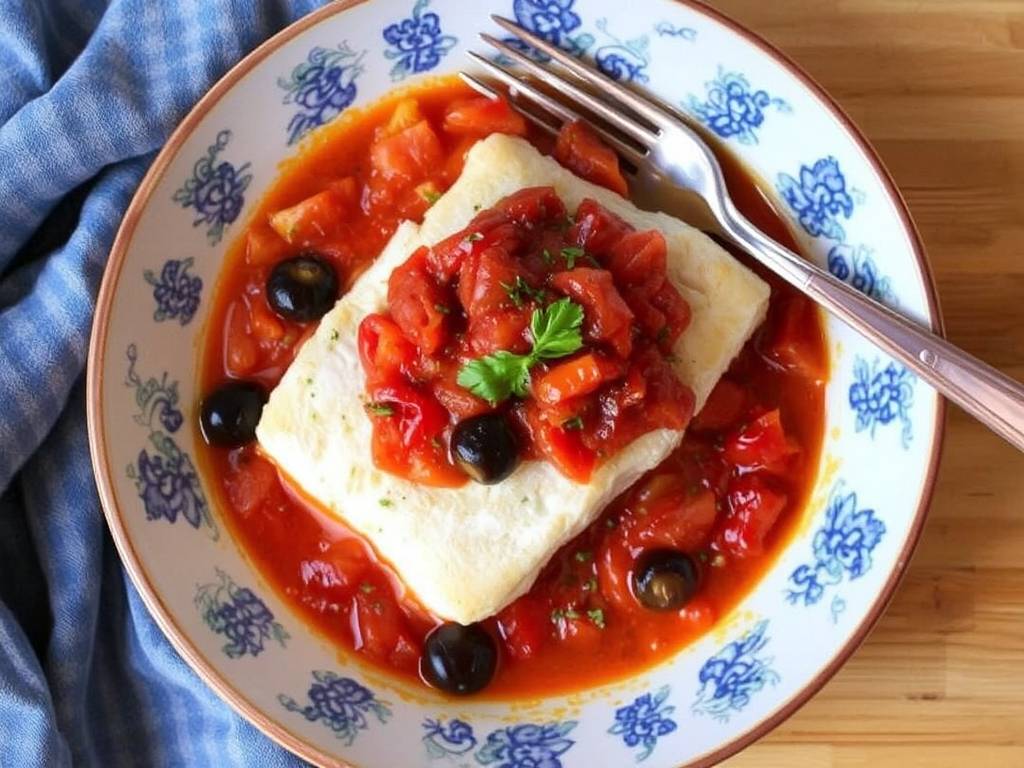A Culinary Journey: Mastering the Art of Baked Cod with Olive and Tomato Sauce
There is a certain elegance to a perfectly cooked piece of fish. It is delicate, flaky, and possesses a subtle sweetness that serves as a pristine canvas for a symphony of flavours. Among the pantheon of fish dishes, baked cod stands out for its accessibility, mild nature, and remarkable versatility. Yet, when paired with the robust, sun-drenched flavours of a homemade olive and tomato sauce, this simple fish is elevated from a humble weeknight dinner to a culinary centrepiece worthy of a celebration. This dish, a beautiful marriage of land and sea, is not merely a recipe but a journey into the heart of Mediterranean cooking, where fresh ingredients and simple techniques yield extraordinary results.

The success of this dish hinges on the quality and harmony of its core components: the cod, the tomatoes, and the olives. Each must be treated with respect and understanding to achieve the final, harmonious balance.

Selecting and Preparing the Cod
The star of our show is, without a doubt, the cod. A member of the whitefish family, cod is prized for its large, tender flakes and low oil content. When shopping for cod, you have several options. Fresh cod fillets are ideal; look for pieces that are pearly white, translucent, and firm to the touch, with a clean, briny scent of the ocean. Avoid any fillets that appear dull, dry, or have a strong, fishy odour.
Frozen cod is an excellent and often more sustainable alternative. High-quality frozen-at-sea cod can be superior to "fresh" fish that has been languishing on ice for days. The key is to thaw it properly. The best method is to place the vacuum-sealed package in a bowl of cold water in the refrigerator for several hours or overnight. This slow thawing preserves the texture and moisture of the fish. Never thaw cod at room temperature or in warm water, as this can lead to a mushy, watery result.
Once your cod is ready, pat it thoroughly dry with paper towels. This crucial step ensures a beautifully seared surface if we choose to pan-sear it first, and it prevents excess water from leaching into our sauce during baking. Season the fillets generously on both sides with sea salt and freshly ground black pepper. Some recipes call for baking the cod directly in the sauce, but for an added layer of flavour and texture, consider a quick sear. Heat a tablespoon of olive oil in an oven-safe skillet over medium-high heat. Once the oil shimmers, place the cod fillets presentation-side down and sear for just 60-90 seconds, until a golden-brown crust forms. This step is optional but highly recommended, as it locks in moisture and adds a delightful textural contrast to the soft sauce.
Crafting the Soulful Sauce: Olives and Tomatoes
While the cod rests, we turn our attention to the soul of the dish: the sauce. This is where the magic happens. The foundation is a classic sofrito—a flavour base common in Mediterranean cuisines. Begin with a good glug of extra-virgin olive oil in the same skillet (if you seared the cod) or a fresh oven-safe pan. Over medium heat, sauté one finely chopped yellow onion until soft and translucent, about 5-7 minutes. Add three or four cloves of minced garlic and cook for another minute until fragrant, being careful not to let it burn.
The choice of tomato is paramount. While you can use high-quality canned crushed tomatoes, there is a distinct advantage to using fresh, ripe plum or Roma tomatoes when they are in season. Blanch them in boiling water for a minute, then transfer to an ice bath. The skins will slip off easily. Chop the peeled tomatoes, and you will have a sauce with a brighter, fresher flavour. For a richer, deeper sauce, canned San Marzano tomatoes are the gold standard. Their low acidity and sweet flavour are unparalleled. Crush them by hand for a rustic texture.
Add the tomatoes to the pan with the onions and garlic. Stir in a tablespoon of tomato paste to intensify the tomato flavour. Now, for the aromatic elements: a generous pinch of dried oregano, a sprig of fresh thyme, and a pinch of red pepper flakes for a subtle warmth. Let this mixture simmer for 10-15 minutes, allowing the flavours to meld and the sauce to thicken slightly.
Now, for the pièce de résistance: the olives. Not all olives are created equal for this dish. While black olives can be used, the complex, briny, and slightly fruity flavour of Kalamata olives is the ideal choice. Their deep purple colour also adds visual appeal. Use pitted Kalamata olives, and if you wish, slice them in half or leave them whole. Stir a generous half-cup of these olives into the simmering sauce. For an extra burst of flavour, add a tablespoon of capers, rinsed to remove excess salt. A splash of dry white wine, allowed to reduce for a minute, will add a layer of acidity that brightens the entire dish. Finally, stir in a handful of freshly chopped flat-leaf parsley.
The Art of Assembly and Baking
Preheat your oven to 400°F (200°C). If your sauce is not already in an oven-safe skillet, transfer it to a baking dish. Taste the sauce and adjust the seasoning with salt and pepper. Remember, the olives and capers are salty, so be cautious.
Nestle the seared (or raw) cod fillets into the warm sauce, spooning a little over the top. The sauce should come partway up the sides of the fish but not completely submerge it. This setup allows the top of the cod to cook gently in the oven's dry heat while the bottom steams in the moist sauce, resulting in perfectly cooked fish from top to bottom.
Place the skillet or baking dish in the preheated oven. The baking time is critical and depends entirely on the thickness of your fillets. A good rule of thumb is to bake for 10-12 minutes per inch of thickness. The cod is done when it turns opaque white and flakes easily with a fork. It should feel firm to the touch but still moist. The most common mistake is overcooking, which turns this delicate fish tough and dry. It is better to undercook slightly, as the residual heat will continue to cook the fish after it's removed from the oven.
Serving and Variations: A Dish of Endless Possibilities
Once baked, remove the dish from the oven and let it rest for a couple of minutes. Just before serving, drizzle with a final thread of high-quality extra-virgin olive oil and a scattering of fresh parsley or basil. The final touch, which is non-negotiable for many, is a grating of lemon zest and a squeeze of fresh lemon juice. The citrus cuts through the richness of the sauce and elevates the flavour of the cod brilliantly.
This dish is a complete meal in itself but begs for simple, complementary sides. Creamy mashed potatoes or soft polenta are magnificent for soaking up the delicious sauce. For a lighter option, serve it over a bed of couscous, quinoa, or with a slice of crusty, grilled bread to mop up every last bit. A simple arugula salad with a lemon vinaigrette provides a peppery contrast.
The beauty of this recipe lies in its adaptability. You can create a Spanish-inspired version by using green Manzanilla olives and adding a pinch of smoked paprika (pimentón). For an Italian twist, use Gaeta olives and add a few anchovy fillets melted into the onion base. You can incorporate artichoke hearts or roasted red peppers for additional texture and sweetness. The recipe is a template—a guide to understanding flavour pairings—encouraging you to become the architect of your own culinary creation.
Baking cod with olive and tomato sauce is more than following a set of instructions; it is an exercise in balancing flavours and textures. It teaches the cook to respect the delicate nature of fish while embracing the bold, rustic character of a Mediterranean sauce. From the careful selection of the cod to the slow simmering of the tomatoes and the final, brightening squeeze of lemon, each step is a deliberate move towards creating a dish that is both comforting and sophisticated. It is a testament to the fact that the most memorable meals are often born from the simplest, finest ingredients, prepared with care and passion.






发表评论